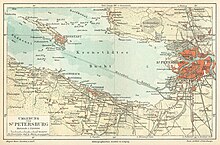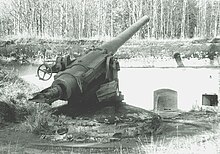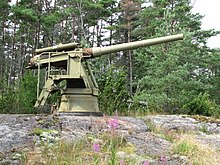Sea fortress of Emperor Peter the Great
The sea fortress of Emperor Peter the Great ( Russian Морская крепость Императора Петра Великого ) is a coastal fortification built at the beginning of the 20th century on and in the Gulf of Finland west of Saint Petersburg . Due to the war, due to the outbreak of World War I, not completed, large parts of the facility are now located on the territories of Finland and Estonia .
background
After Russia's defeat in the Russo-Japanese War in 1905, the then Russian capital was largely defenseless, as most of the Baltic Fleet , which had been ordered to the Far East as the Second Russian Pacific Squadron to relieve the First Russian Pacific Squadron enclosed in Port Arthur , was in the Sea battle at Tsushima was lost. A deep defense in the Gulf of Finland was intended to prevent enemy naval forces from accessing Saint Petersburg. The first plans were drawn up in 1907. The Russian Emperor and Tsar Nicholas II ( Russian: Николай II ) confirmed the plans on July 5, 1912. Work began a short time later.
investment
The sea fortress consisted of four concentrically arranged defense rings. The core of the system were fortified positions of large-caliber coastal guns, which were supported in their effectiveness by minefields and positions of light artillery. The fortifications around the capital of the Grand Duchy of Finland Helsinki, which was then in personal union with Russia, as well as other fortifications on the coast flanked the sea fortress.
The inner defense ring stretched from Fort Krasnaja Gorka ( форт Красная Горка - Red Hill) near Oranienbaum across the island of Kotlin with Kronstadt with Fort Konstantin to Fort Ino ( форт «Ино» or форт Николаевский ) on the Finnish bank. The right flank was protected by the coastal fortifications of Vyborg ( Russian Выборг ; Finnish Viipuri ).
The second line of defense stretched from Narva to Kotka .
The third ring of defense, the so-called Central Position, began in Reval and led to the Porkkala peninsula west of Helsinki . This line was the main defense position. It was flanked by the sea and land fortifications of the Sveaborg Fortress ( Крепость Свеаборг ). At the same time, Reval was to be expanded to become the main war port - while the previously preferred port of Libau (see also: Karosta ) and the secondary port of Dünamünde were given up and downgraded to advanced ports.
The fourth, outer line, known as the Front Position, began on the island of Hiiumaa and stretched across the Gulf of Finland to the Hanko Peninsula .
Further to the west, the coastal fortifications on the Åland Islands were upstream on the right flank and Saaremaa Island on the left flank.
The gun emplacements were set up on the shores of the Gulf of Finland and on numerous small islands. Their position was chosen so that the fire areas overlapped and the guns could block the passage through the bay. This was particularly evident in the third defensive ring, which was built on the narrowest, only 36 km wide point of the Gulf. Where the range of the guns was insufficient, additional minefields were created between the fire areas.
Armament

The core of the system was the positions for large-caliber guns. Variants for coastal defense were developed for the largest Russian naval guns at the time, the 305 mm L / 52 cannon M1907 and the 356 mm L / 52 cannon M1913 . The guns themselves remained largely unchanged, only by enlarging the powder chamber the firing of other types of ammunition was made possible. The guns were installed in twin towers (MB-2-12 and MB-2-14), which were structurally the same as those used on the new Russian battleships . These guns were stationed together with the auxiliary systems, observation and fire control points in fixed, bunkered positions. During the First World War , railway guns were developed from both types of gun . The variant of the 305 mm cannon received the designation TM-3-12, that of the 356 mm cannon the designation TM-1-14. Both variants were also stationed in the sea fortress. Due to the mountings, they were relocatable and were therefore sporadically assigned to individual works of the fortress to form a focus.
Smaller calibers were preferably set up in open positions, but sometimes also in casemates.
Among other things, the following were used:
- Fort Ino
- 4 × 305 mm L / 52 cannon M1907 in open barbette
- 4 × 305 mm L / 52 cannon M1907 in two twin turrets MB-2-12
- 8 × 280mm howitzers
- 8 × 254 mm L / 45 cannon M1891
- 4 × 152 mm L / 45 canet guns
- Fort Constantine
?
- Fort Krasnaya Gorka
- 4 × 305 mm L / 52 cannon M1907 in open barbette
- 4 × 305 mm L / 52 cannon M1907 in two twin turrets MB-2-12
- 8 × 280mm howitzers
- 8 × 254 mm L / 45 cannon M1891
- 36 × 152 mm L / 45 canet guns
- Mäkiluoto:
- 4 × 203 mm L / 50 cannon M1905
-
Naissaar :
- 4 × 305 mm L / 52 cannon M1907
- 4 × 234 mm L / 50 cannon M1908
- 4 × 203 mm L / 50 cannon M1905
- 4 × 152 mm L / 45 cannon M1892
- 4 × 120 mm L / 50 cannon M1905
-
Aegna :
- 4 × 305 mm L / 52 cannon M1907
-
Viimsi :
- 4 × 120 mm L / 50 cannon M1905
- Suurupi:
- 4 × 234 mm L / 50 cannon M1908
- Kakumägi
- 4 × 120 mm L / 50 cannon M1905
- Cape Tachkona on Dagö
- 4 × 305 mm L / 52 cannon M1907
- Cape Zerel on the Sworbe peninsula on Ösel
- 4 × 305 mm L / 52 cannon M1907
- Woi to Moon
- 5 × 254 mm L / 45 cannon M1891
use
When Russia left the war in 1917, the fortress was not yet completed and not all of the works were manned. Since the beginning of the war, work has been done gradually on reinforcement and the fortress apron has been moved up to the Aland Islands - Ösel - Gulf of Riga line. The positions around the Gulf of Riga as well as Ösel and Dagö were captured by German troops as early as autumn 1917 during the Albion operation . After Finland's independence and the secession of Estonia in 1918, parts of the fortress and thus the weapons there were in Finnish and Estonian possession. Positions on the now Finnish bank were taken in 1918 by troops of the Baltic Sea Division under the leadership of the German General von der Goltz . During this time, numerous artillery pieces, especially smaller ones, were removed from their positions or made unusable by their respective owners. After the end of the Russian Civil War , only the positions of the inner ring immediately in front of St. Petersburg were in the hands of the Soviets . The situation had turned into the opposite for the Soviet Navy . By owning the positions Finland and Estonia could block Saint Petersburg and deny the Baltic fleet access to the Baltic Sea. In the 1930s, the two states made considerable efforts to expand the fortress as part of the Estonian-Finnish defense cooperation. The blocking effect was reinforced by additional mine barriers and submarines. As a result of the Winter War and the Soviet occupation of the Baltic States, the positions fell back into Soviet hands, but they were lost again in the Continuation War and after the German attack on the Soviet Union. During these armed conflicts there was destruction and the reconstruction of the positions and individual batteries. After the end of the Second World War , the Baltic States remained part of the Soviet Union until 1991, while Finland had to lease part of the bases to the Soviet Union as a result of the lost Continuation War. However, these bases were returned to Finland in 1956, as Kaliningrad had meanwhile become the main base of the Baltic Red Banner Fleet . Some of the positions of the fortress were used by Finland until the 1970s.
Remarks
- ↑ Designation scheme : type of carriage / tower - type of execution - caliber in inches; MK stands for tower for ships; MB for coastal artillery tower, TM for railway carriage
literature
- Леонид Ильясович Амирханов: Морская крепость Императора Петра Великого. Издательство "Иванов и Лещинский", Санкт-Петербург 1995, ISBN 5-86467-020-0 .




